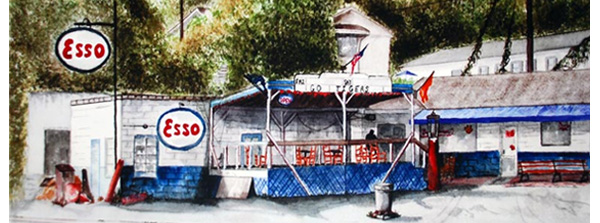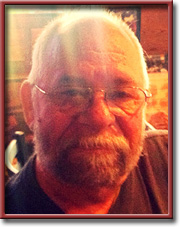William A. Balk, Sr.’s “Wartime Experiences of a Colorblind Navy Pilot—2.1”
“When we were finished for the night, we got ready to fly back to Pearl Harbor. We usually had more pilots than planes and took turns piloting, which meant some had to ride as passengers back to Pearl. That was when we discovered that Jack Chrystal was missing.”—By William A. Balk, Sr.
Dispatches from The Esso Club
By Ted Balk
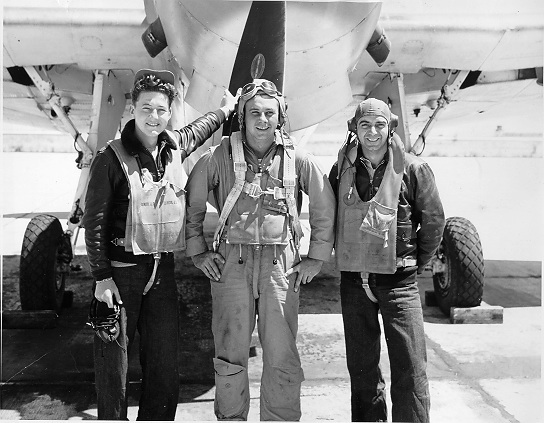
CENTRAL South Carolina—(Weekly Hubris)—5/5/2014—
CHAPTER I
Shakedown Cruise to Guadalcanal
In mid-April 1944, the USS Marcus Island left San Diego for Australia, returning in early July. This was the newly launched ship’s shakedown cruise—a chance for the crew to get thoroughly familiar with shipboard operations without the distraction of aircraft landing and taking off, and the problems that engendered. The trip was spent ferrying supplies to and from the South Pacific and Australia.
By mid-July, the ship had been re-provisioned and was ready to take our squadron aboard and head to the war zone. We were designated Composite Squadron VF-21, and comprised twelve FM2 “Wildcat” fighters and eleven TBM “Avenger” torpedo-bombers. Shortly before departure time, a large truck pulled alongside one of the loading ramps and began loading cases of beer and whiskey onto the ship. This had all been arranged before-hand, probably by L.O. Nelson, but most of us contributed. These special supplies were immediately stored in a chain locker and heavily padlocked. Navy rules strictly forbade the consumption of alcohol aboard ship, but we could go ashore and set up a Point Easy on one of the islands. Luckily, Captain Greber was an understanding C.O. and went along with this. Whoever thought up this idea deserves a medal.
In mid-July, we left San Diego and headed for the South Pacific, via Hawaii. We pulled into Pearl Harbor at the end of the month and, as it turned out, stayed about two weeks. We had a chance to visit Waikiki Beach, the Royal Hawaiian Hotel, the Royal Palace, and other points of interest. While we were there, Franklin Roosevelt showed up, but nobody seemed interested in him. The main reason we stayed two weeks was that somebody in CincPac had decided that we had better get proficient in night carrier landings before we proceeded any further. Apparently, this was the first time it had occurred to anybody that there might be situations where this would be useful. Man, were they ever right. Later, this became routine but, at the time, it generated absolutely no enthusiasm among the squadron.1
To understand the difficulty in this you have to understand the way ships operate at night in a combat area. A task group of CVEs (our type of carrier) usually consisted of four carriers and four to eight support ships which were either DEs (escort destroyers) or DDs (full-size destroyers). By contrast, a task group of CVs (large carriers) would have, in addition, several cruisers and battleships.
In any case, no external light was permitted on any ship with the exception of one red light at the highest point of each vessel. On the carriers, there was another exception. During landing operations, they were allowed to show four very dim, hooded lights on each side of the touch down area of the flight deck. These could only be seen from a plane when it was at the proper position and altitude for landing, about three seconds before touch down. In addition, the Landing Signal Officer wore luminescent clothes and used signal paddles that would reflect black light. It was an eerie sight on the final approach when this human form seemed to materialize in the middle of the Pacific, waving a couple of ping pong paddles at you.

We were totally dependent on the LSO to judge our altitude, speed, and position so that when he signaled “cut engine” we would roll out of the turn, visually pick up the flight deck lights, and flare out for the touch down. This had to be with zero flying speed because if we hit hard and bounced, as happened in rough weather, we could miss a cable with the tail hook and crash into the barriers. Even worse, we could go over the barriers and into the planes parked forward.
The barriers were a series of cables stretched across the deck at chest height between the arresting cables and parked planes. If a landing aircraft safely engaged an arresting cable with its tail hook, the barriers were sequentially lowered as the plane progressed up the deck while stopping. If the tail hook didn’t engage, the barrier operators would leave them in place to stop the plane, usually by upending it, before it could crash into the parked planes. This caused some damage, mostly to the propellers, but the option was well worth the trade-off. A crash into the parked planes could be fatal to the entire ship, depending on the amount of fuel and ammunition involved.

We were blessed with two great LSOs, Robbie Roberts and Tony Costa. Their job was hard enough with daylight landings, but at night it was next to impossible. The only way they could judge speed, altitude, and position was by three small lights—red, amber, and green—located six inches apart along the plane’s belly. The way these lined up was supposed to tell the LSO all he needed to know to signal a cut or to wave us off again. (Recently, at a squadron reunion, Robbie told me that he depended more on the sound of the engine than anything else.) A wave off was mandatory on our part even if we knew we might run out of gas.
The LSOs didn’t like to give wave offs and rarely did, but sometimes the previous plane may not have cleared the barriers or the ship was pitching on a hard upswing and likely to cause a bad bounce. These occasions were, thankfully, rare. If we were going to be able to do night landing, we had to get some more training and this meant night field carrier landings first.
According to my flight log, by this time I had made 22 carrier landings and logged a total of 650 hours flying time, with 35 hours on instruments (flying under a hood with only needle ball and airspeed indicator for instruments). The ability to fly on instruments was essential in this situation where we flew at about 50 feet above the ground with absolutely no visible horizon and no landmarks.2 We practiced at Barber’s Point, a few miles from Pearl Harbor, where there was a small landing strip.
We would fly in before dark and then, when everything was black, set up a landing pattern around the strip with four or five planes in the air. There were imitation deck lights on one end of the strip and Robbie or Tony would set up a black light system near these to illuminate themselves. Then, for the next several hours, we would make touch-and-gos and circle over the neighbors’ houses at 50 feet. We never heard of any complaints but, if I had lived there, I would have been very uneasy, as well as irritated.
On one of these sessions, when we were finished for the night, we got ready to fly back to Pearl Harbor. We usually had more pilots than planes and took turns piloting, which meant some had to ride as passengers back to Pearl. That was when we discovered that Jack Chrystal was missing. His passenger couldn’t find his pilot. Remember, we didn’t have any lights, so it was hard to tell how many planes were on the ground. While we were debating what to do about this situation, a Jeep drove up and Jack got out, dragging his open parachute with him. His engine had quit while in the landing circle and, of course, he had nowhere to go but down. He plowed through some small trees until his plane knocked over a stone wall surrounding an observation post or bunker. Of course, he jumped out of the plane thinking it might catch fire and started moving rapidly away from it. Somewhere along the way, his parachute rip cord got pulled and the chute hung on some bushes. The people from the observation post helped extricate him, then provided transportation back to the air strip where we were still trying to figure out how to go about finding him.3
We also did some night field carrier landing practice at Kaneohe, which was a small Naval Air Station on the east side of Oahu. It was hard to understand why this station existed, but it sure had a wonderful BOQ situated on a cliff overlooking the surf crashing against the rocks below. The permanent personnel seemed a little weird and also privileged (one was Jerry Colonna, famous as a movie comedian back then), so I guess this was a good place to stash them for the duration. While we were there an event occurred which may have been a precursor of similar conduct today. One guy met another walking down the hall. He pulled out a pistol and shot the other in the chest. As the victim lay dying on the floor, he kept saying, “I don’t know why. I don’t even know him.” I guess you could call this a “walk-by” shooting comparable to our “drive-by” shootings today.
During the first week of August, the Marcus Island was back at sea, operating off the coast of Oahu. We spent a few days flying from both Kaneohe and the carrier and became proficient at night carrier landings during this time.
On August 8, we again headed for the South Pacific, destination: Tulagi Harbor in the Solomon Islands.
On the trip from San Diego to Pearl, we had been unable to carry out flight operations because all available space was used for transporting replacement aircraft and other supplies for delivery to Pearl Harbor. Now the ship was rigged for combat operations and, for this trip, we served as escorts for a convoy. This meant that we maintained air cover in the form of ASP and CAP from sun-up to sundown. Anti-Submarine Patrol, ASP, was flown by TBMs, and Combat Air Patrol, CAP, was flown by the fighters. This was all pretty much routine and uneventful from a flying standpoint, but things got really rough when we crossed the equator.
Navy tradition has it that anyone crossing the equator for the first time must be initiated into the “Solemn Mysteries of the Ancient Order of the Deep,” presided over by King Neptune’s Court. The ceremonies were designed to change the initiates from “Pollywogs” to “Shellbacks” by subjecting them to a series of indignities such as kissing the Royal Baby’s belly (a big, fat, hairy, greasy machinist), crawling through the slop chute (a 50-foot long canvas tube full of ripe dishwater and garbage), getting a “haircut,” confinement in the stockade, running the gauntlet, and much more. This went on for two days with all activities enforced by the numerically superior Shellbacks with their shillelaghs. We were unarmed because we hadn’t known what we were getting into. We put up a pretty good resistance, but I don’t know of anyone who wasn’t black and blue on most of his body.
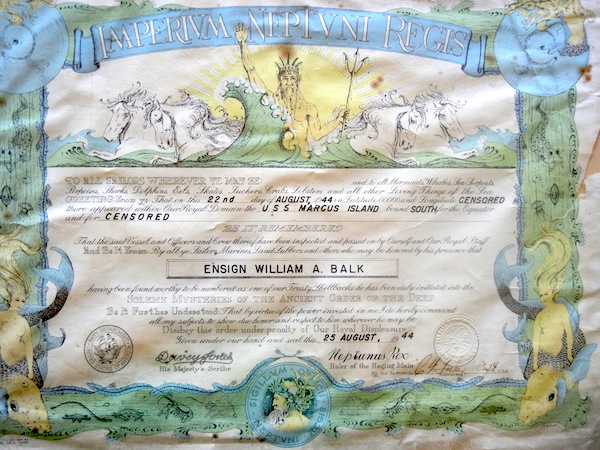
The rest of the trip was uneventful, except when Jones made a crash landing in the water and got tangled in his parachute while getting out of the plane. His air crew managed to cut him loose and a DE promptly fished them out of the water. As a result of this episode, we learned of another tradition. When a destroyer returns an airman to the carrier, the carrier is obligated to supply ice-cream to the entire destroyer’s crew. A carrier has the machines for making ice-cream, but a destroyer doesn’t. I suppose there could have been some occasions where the carrier refused to pay the ransom, but that would depend on who the pilot was.
We pulled into Tulagi at the end of August and stayed about two weeks. This time was spent conducting tactical maneuvers with a Marine Corps division on the beaches of Guadalcanal in preparation for the invasion of Pelelieu in the Palau Islands.
Incidentally, one of the most notable things about Tulagi Harbor at that time was a huge sign, larger than any on our interstate highways, built on the side of the hill facing the harbor entry. It read:
KILL JAPS, KILL JAPS
KILL ALL THE YELLOW BASTARDS
HALSEY
At the time, I don’t think anyone there felt offended by this message.
We managed to have time for a beer bust ashore and a baseball game with the ship’s officers before departing for the Palaus. As usual, nobody could figure out who won or what the score was.
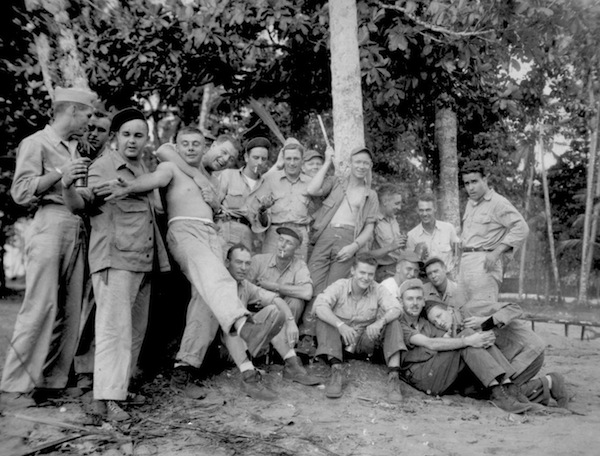
To be continued . . .

Chapter End Notes
1. Night Carrier Landings
The decision to require proficiency in night carrier landings may have stemmed from events surrounding the “Great Marianas Turkey Shoot.” This was the name given an air battle that occurred shortly after the invasion of Saipan on 19 July 1944. As reported by Thomas J. Cutler in his Battle of Leyte Gulf, and also by Samuel Eliot Morrison in his history of the Pacific War, this was an all-day affair in which the Americans shot down 346 enemy planes while losing only 30 of their own. This battle greatly reduced the number of veteran pilots available to the Japanese fleet because of their policy of keeping pilots in combat until they were lost. The American Navy, by contrast, rotated its experienced pilots back to the States for training duties. Since this was an all-day battle, some of the US planes probably returned to their carriers after dark. Lack of training for night landings could have accounted for some of the 30 planes lost. One month later, we were in the process of correcting this oversight.
2. Instrument Flying
Proficiency in instrument flying was absolutely essential for survival during carrier combat operations. On early morning take-offs, we were frequently catapulted into pitch-black darkness, 30 or 40 feet above the sea, with borderline flying speed. During the next few seconds, we had to get the wheels up, the trim tabs adjusted, the landing flaps up, the engine throttled back, the rpms reduced, and also make a hard jog to the right so that the turbulence we created would not interfere with the next launching. Each of these procedures was necessary for a specific reason. A crash landing at sea is much safer with wheels up. Extended wing flaps give a plane extra lift, but they also retard air speed. In this situation, especially with the slow moving small carriers, we were striving for both flying speed and altitude and using all available power. If we maintained full power at low air speed for too long, the engine could overheat and cause detonation in the cylinders. In a matter of seconds, this translated into engine failure, and down you went. Under these conditions, instrument flying had to be almost as natural as visual flying: you couldn’t waste seconds trying to understand what the instruments were telling you. Usually, Jack Chrystal and I maintained our instrument proficiency by training together in a two-seated SNJ that had one cockpit equipped with a canvas hood, which effectively simulated zero visibility flying conditions. While one of us attempted to fly the plane with only needle ball and airspeed instruments to indicate the plane’s orientation to level flight, the other rode in the uncovered cockpit to avoid and correct any dangerous situations that might develop. Although our TBMs were equipped with the most advanced flight instruments available at the time, the gyros used to operate these were easily tumbled during our type of flying, making them unreliable in an emergency. Our standard policy was to rely only on the basic flight instruments.
3. Sequel to Jack Chrystal’s Crash Landing
Erla Chrystal provides an interesting addition to the episode about Jack’s controlled crash landing during the Barber’s Point night field carrier landing exercises. The stone wall that finally stopped the plane was near a bunker, or observation post, occupied by military personnel. The guy that brought Jack back in the Jeep was on duty in the bunker at the time Jack suddenly dropped in on them. Years later, it turned out that they both wound up employed by the Jeffrey Company in Columbus, Ohio. They discovered this at work one day and, after making the connection and recognizing each other, had a great time rehashing the incident.
